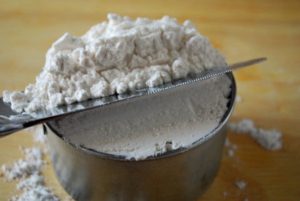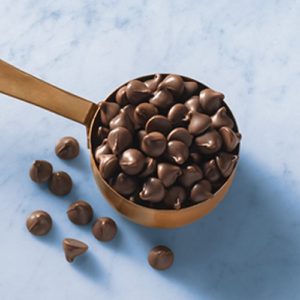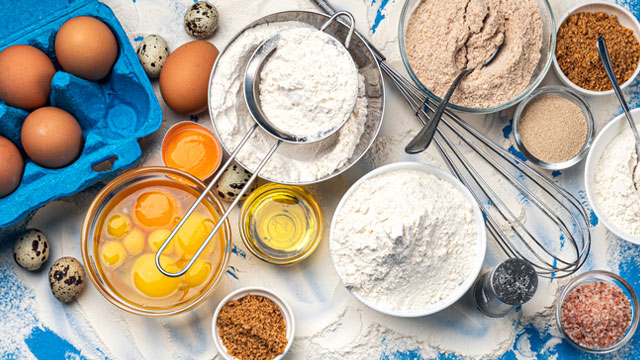A good baker needs proper measuring skills. We will show you how to measure dry ingredients accurately.
Baking is a lot like chemistry. Therefore, adding too much flour to your cake batter may result in baking a dry and tough cake. On the other hand, your cake will collapse in the oven if you do not add enough flour.

Measuring Volume
Measuring volume means measuring how much space something occupies. It’s generally used as a form of measurement for most baking recipes in the US. The most common units of volume are teaspoons, tablespoons, cups, gallons, quarts, pints, and fluid ounces.
Let’s make something clear. You cannot assume a coffee cup, a teacup or a mug is the same as a measuring cup.
For volume measurements, having an accurate set of different-sized dry and liquid measuring cups is a good start. Don’t forget a set of measuring spoons.
In the United States, one cup equals around 240 milliliters*. Some recipes can be made by volume measurements with a container of choice (theoretically a coffee mug can be used to measure the ingredients). However, in general, you must make sure you are using graduated measuring cups and spoons when baking.
* It’s 236.6. As volume measurements are essentially imprecise, 240 is good enough.
Since a tablespoon is also a standardized unit of measurement, you cannot use an ordinary dinner spoon if a recipe requires you to use a tablespoon of baking powder.
Dry vs wet ingredients
You can measure wet ingredients, such as milk, or water in dry and wet measures. The weight of a dry measuring cup of milk should be the same as a weight of a wet measuring cup of milk. However, a dry measuring cup must be as full as possible, which sometimes makes measuring liquids in dry measuring cups impractical. The same goes for dry ingredients, they can be measured in a liquid measure, but leveling dry ingredients accurately is very difficult.
Click here and find out how much does a gallon of water weigh
Measuring dry ingredients using dry measuring cups
Different methods can be used to fill a dry measuring cup with sugar or flour. You can sift, use a spoon or a scoop to fill a dry measuring cup. The method which you will use for filling a cup can seriously alter the mass of the ingredient you measure.
You can dip your dry measuring cup into the container and by lifting it out, let the dry ingredient overspill from the top. For leveling off the top of the cup you can use an edge of a butter knife. A dry cup of flour is precisely measured when having a flat top surface that is level with the edge of a cup.

Why are dry measures inherently inaccurate?
When measuring dry ingredients by volume, the problem lies in the compressibility of the ingredients. For instance, you can easily compress flour by scooping, spooning, or packing it into a measuring cup.
If you fill a cup by dipping it into a container, it can weigh as much as 50% more than a cup that you fill by sifting flour into it!
Even if you use the same method, the amount of flour in a cup can be different. The difference depends on how light-handed or rough you are when you scoop a cup.
A lightly scooped cup and a firmly scooped cup can have different weights. The contrast in weights can make you a successful baker or cause you to fail in a recipe.
To make a cup weigh the same each time, you must practice a lot.
Click here to convert any unit online
Measure by weight
The Ounces and Fluid Ounces aren’t the same
A unit of weight – ounces
A unit of volume – fluid ounces
If you measure water, one fluid ounce weighs the same as one ounce of weight. However, this ratio can alter based on the density of what you are measuring. The encouraging news is that usually, one fluid ounce of any liquid in cooking will equal an ounce. So, the slight difference will not affect your results much.
Two different systems of measurement sharing the same name can be confusing. For example, a recipe tells you to use eight ounces of chocolate chips. Does the recipe refer to weight (ounces on a scale) or volume (dry measure cup filled with chips)?

In the US, if you see a dry ingredient in ounces, it is a unit of weight. However, if you see a wet ingredient in ounces, it is fluid ounces, and you should measure in a wet measuring cup. However, when weights are listed before volumes, ingredients should be measured on a scale.
Why is measuring by weight better?
If you want to be successful at baking and avoid washing the cups/spoons, it is time to think about investing in a good digital scale.
- More accuracy. No compressibility issues. Three ounces of flour is always three ounces of flour, it doesn’t matter how you transfer it to your bowl. So, every time you bake, it is guaranteed that the ratio of ingredients will be the same.
- Less mess. Using a scale for measuring ingredients is easier because you do not have to wash an array of measuring cups. You only need one or two mixing bowls when measuring by weight.
Here you can watch how to measure dry ingredients like a pro
